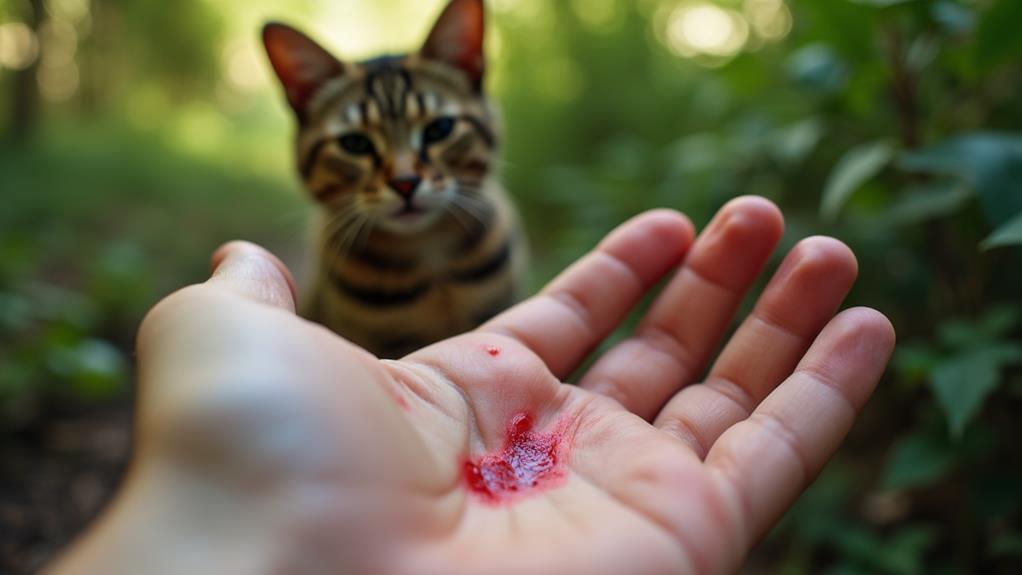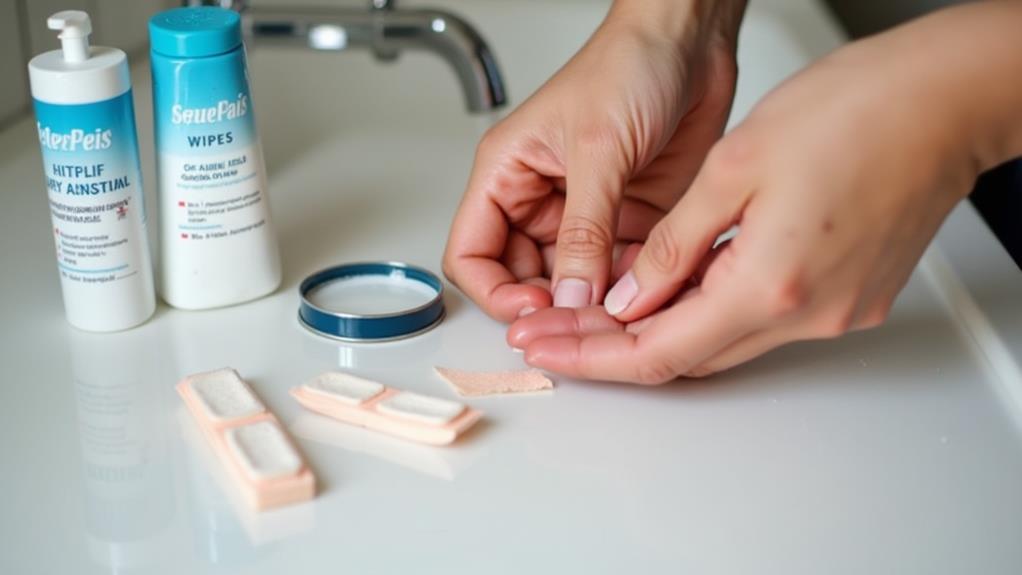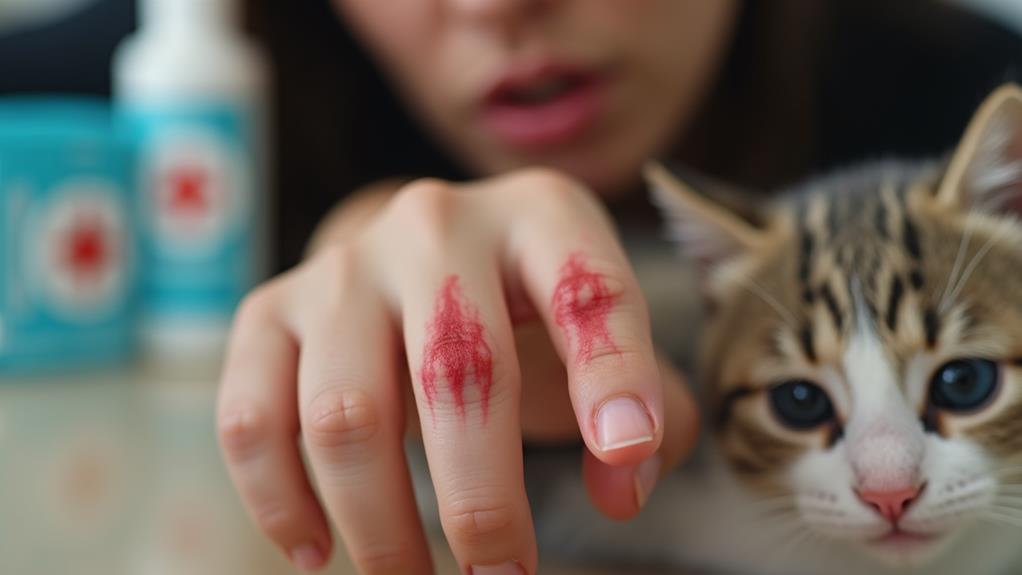What Happens If a Feral Cat Scratches You? Health Risks and Treatment

If a feral cat scratches you, you risk contracting cat scratch disease (CSD) from bacteria in the cat's saliva. Look out for symptoms like redness, swelling, and fever, which may appear days after the scratch. Clean the wound immediately with soap and water, applying antibiotic ointment and a sterile bandage. Monitor the area for signs of infection, and consult a healthcare provider if symptoms worsen or if you have a compromised immune system. Avoid future scrapes by being cautious around feral cats, and consider further steps to protect your health and prevent long-term issues.
Health Risks of Cat Scratches
When dealing with cat scratches, it's imperative to understand the potential health risks involved. Cat scratch disease (CSD) is a primary concern, caused by the bacterium Bartonella henselae. This bacterium is found in the saliva of infected cats and can be transmitted to you through scratches or bites. Once exposed, you might notice symptoms of infection like swollen lymph nodes and fever appearing approximately 3 to 10 days later.
The risk of infection can be significant, especially if you don't clean the wound promptly. Delayed treatment increases the chances of complications, such as persistent lymphadenopathy or even systemic illness. It's crucial to keep in mind that infections aren't limited to CSD alone. Other pathogens, like Pasteurella multocida or Methicillin-resistant Staphylococcus aureus (MRSA), can also be transmitted, particularly if your immune system is compromised.
If you experience flu-like symptoms or notice signs of infection like redness, swelling, or pus around a deep scratch, it's vital to seek medical attention immediately. Taking quick action is essential to prevent the situation from worsening. Always be cautious with an infected cat, and make sure any scratches are cleaned right away to minimize health risks.
Symptoms to Watch For
Numerous symptoms can signal a potential infection from a feral cat scratch, and being vigilant is fundamental. Recognizing these signs early can help prevent complications. Here's what you should watch for:
- Redness and Swelling: Within days of the scratch, you might notice redness or swelling at the injury site. These symptoms often point to an infection.
- Lymph Nodes: Be aware of painful or swollen lymph nodes near the scratch area. This symptom typically appears 1-3 weeks after the incident and may indicate cat scratch disease (CSD), caused by the bacterium Bartonella henselae.
- Flu-like Symptoms: If you develop fever, fatigue, or joint pain, it could signal CSD. These symptoms mimic other conditions, so seeking medical advice is imperative for accurate diagnosis.
- Pustules: The appearance of pustules at the scratch site is another red flag. It suggests an infection that requires close monitoring.
If you experience any of these symptoms, don't hesitate to consult a healthcare professional. Early intervention can prevent more serious health issues. Remember, medical advice is crucial when dealing with potential infections from feral cat scratches.
Immediate Treatment Steps

Prompt action can be vital in minimizing the risk of infection from a feral cat scratch. Start by immediately washing the scratch with soap and warm water for at least 15 minutes. This helps remove bacteria from the cat's saliva, reducing the risk of infection. After washing, pat the area dry with a clean towel. If you notice any bleeding, apply gentle pressure with a clean gauze pad to help control it.
Once you've cleaned the scratch, apply an over-the-counter antibiotic ointment to the affected area. This step is key in protecting the wound from further contamination. Cover the scratch with a sterile bandage to keep it clean and shielded from potential irritants.
It's significant to keep an eye on the scratch for any signs of infection. Look for increased redness, swelling, pus, or flu-like symptoms, and seek medical attention if these occur. If the scratch is particularly deep or if there's any concern about rabies, contact a healthcare provider immediately. They can evaluate the situation and determine if a rabies post-exposure prophylaxis is necessary to guarantee your safety and health.
Preventing Infections
Stepping up your prevention game can greatly lower the risk of infections from feral cat scratches. If you find yourself scratched, immediate action is key. Initially, clean the area thoroughly with soap and warm water to wash away bacteria that might be lurking in the cat's saliva or on its claws. Next, apply an over-the-counter antibiotic ointment to the scratch and cover it with a sterile bandage. This helps shield the area from further infection.
To keep infections at bay, consider these steps:
- Monitor the scratch site for signs of infection, like increased redness, swelling, or pus. If flu-like symptoms appear, it's vital to seek medical help.
- Avoid open wounds when dealing with feral cats to prevent cat scratches from becoming a gateway for bacteria like Bartonella henselae, which causes cat scratch disease.
- Educate yourself on feral cat behavior to reduce the chances of getting scratched or bitten.
- Maintain a flea-free environment for your pets, as fleas can transfer harmful bacteria to feral cats.
When to Seek Medical Help

In the case of seeking medical help for feral cat scratches, don't put it off if you notice severe bleeding or if the wound isn't healing after a few days. These could be signs of more serious health risks, and it's wise to seek medical help promptly. Feral cats can carry infections, and if you develop symptoms like redness, swelling, fever, or flu-like symptoms within 1-3 weeks, it might indicate cat scratch disease. In such cases, consulting a healthcare provider promptly is necessary.
If your immune system is compromised, even a minor scratch can lead to serious infections. Those with weakened immune systems should seek medical advice after any encounter with feral cats, regardless of the severity of the scratch. Be on the lookout for symptoms of infection, such as pus, increasing pain, or swollen lymph nodes. If these are present, it's imperative to see a doctor without delay.
Additionally, if you suspect the feral cat is rabid or the scratch happened during an attempt to handle or rescue the cat, immediate medical attention is crucial. Rabies post-exposure prophylaxis might be necessary, so don't hesitate to consult a healthcare provider.
Long-Term Health Considerations
While immediate medical attention can address the urgent concerns of a feral cat scratch, it's likewise significant to contemplate the long-term health implications. A scratch can transmit cat scratch disease, caused by the bacterium Bartonella henselae, affecting thousands annually. If left untreated, this bacterial infection can lead to persistent health issues. A weakened immune system increases the risk of complications from a cat scratch, demanding vigilant care.
To avoid long-term problems, consider these crucial points:
- Symptoms to Monitor: Look out for swollen lymph nodes, fever, and fatigue. These symptoms can persist for weeks if not promptly treated.
- Complications to Avoid: Without proper medical attention, cat scratch disease can lead to chronic fatigue or, in rare cases, neurological issues.
- Importance of Wound Care: Proper wound care immediately after a scratch is vital. Clean the area thoroughly and seek medical advice to minimize infection risks.
- When to Seek Help: Don't wait if symptoms appear or persist. Early intervention is key to preventing long-term health complications.
Being proactive and informed about these potential issues guarantees you manage the risks effectively and maintain your health.




